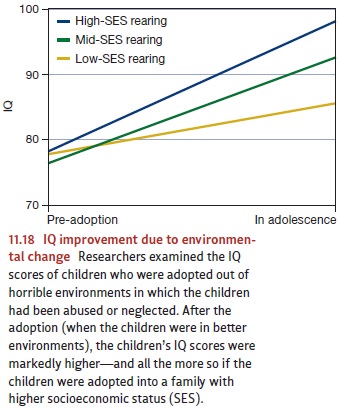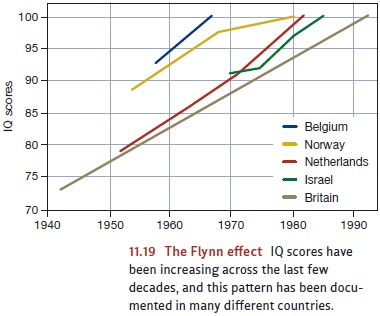Chapter: Psychology: Intelligence
The Roots of Intelligence: Environment and Individual IQ
Environment and Individual IQ
Undeniably,
genetic influences play a powerful role in shaping someone’s intellectual
capacities. Indeed, researchers have begun to explore exactly how these genetic
influ-ences unfold—including an effort to specify which genes, on which
chromosomes, are the ones that shape intelligence. (For glimpses of the modest
progress so far, see Posthuma & deGeus, 2006; Zimmer, 2008.)
As we’ve repeatedly noted, though, genetic effects always unfold within an environ-mental context. So—inevitably—environmental factors also shape the development of our intellect. Evidence for this point comes from many sources; and thus, as we’ll see, the IQ score someone ends up with depends on both her genes and the surroundings in which she grew up.
EFFECTS OF CHANGING THE ENVIRONMENT
The
effect of the environment on IQ scores is evident in many facts. For example,
one Norwegian study examined a huge data set that included intelligence scores
for 334,000 pairs of brothers. The researchers found that the correlation
between the brothers’ intelligence scores was smaller for brothers who were more widely separated in age (Sundet,
Eriksen, & Tambs, 2008). This result is difficult to explain genetically,
because the genetic resemblance is the same for two brothers born, say, one
year apart as it is for two brothers born five years apart. In both cases, the
brothers share 50% of their genetic material. However, this result makes sense
on environmental grounds. The greater the age difference between the brothers,
the more likely it is that the family cir-cumstances have changed between the
years of one brother’s childhood and the years of the other’s. Thus, a greater
age difference would increase the probability that the brothers grew up in
different environments, and to the degree that these environments shape
intelligence, we would expect the more widely spaced brothers to resemble each
other less than the closely spaced siblings.
We’ve
also known for many years that impoverished environments can impede
intel-lectual development. For example, researchers studied children who worked
on canal boats in England during the 1920s and rarely attended school; they
also studied chil-dren who lived in rural mountainous Kentucky, where little or
no schooling was avail-able. These certainly seem like poor conditions for the
development of intellectual skills, and it seems likely that exposure to these
conditions would have a cumulative effect: The longer the child remains in such
an environment, the lower his IQ should be (Figure 11.17). This is precisely
what the data show—a negative correlation between IQ and age. That is, the
older the child (the longer she had been in the impoverished envi-ronment), the
lower her IQ (Asher, 1935; H. Gordon, 1923; also see Heckman, 2006). Related
results come from communities where schools have closed. These closings
typically lead to a decline in intelligence-test scores—in one study, a drop of
about 6 points for every year of school missed (R. L. Green, Hoffman, Morse,
Hayes, & Morgan, 1964; see also Ceci & Williams, 1997; Neisser et al.,
1996).

More
optimistically, we also know that improving
the environment can to some extent increase
IQ. For example, in a study in France, researchers focused on cases in
which thegovernment had removed children from their biological parents because
of abuse or neg-lect (Duyme, Dumaret, & Tomkiewicz, 1999) The researchers
were thus able to compare the children’s “pre-adoption IQ” (i.e., when the
children were still living in a high-risk environment) with their IQ in
adolescence—after years of living with their adoptive fam-ilies. The data (Figure
11.18) showed substantial improvements in the children’s scores, thanks to this
environmental change.

A
similar conclusion flows from the effects of explicit training. The Venezuelan
“Project Intelligence,” for example, gave underprivileged ado-lescents in
Venezuela extensive training in various thinking skills (Herrnstein, Nickerson,
de Sanchez, & Swets, 1986). Assessments after training showed substantial
benefits on a wide range of tests. A similar benefit was observed for American
preschool children in the Carolina Abecedarian Project (F. A. Campbell &
Ramey, 1994). These programs leave no doubt that suitable enrichment and
education can provide substantial improvement in intelligence-test scores. (For
still other evidence that schooling lifts intelligence scores, see Ceci &
Williams, 1997; Grotzer & Perkins, 2000; M. Martinez, 2000; Perkins &
Grotzer, 1997.)
We
should note in passing that there’s no conflict between these results and the
results we mentioned earlier when docu-menting the reliability of the IQ test. There we noted that IQ scores are
usually quite stable across the life span, so that (for example) if we know
someone’s IQ at, say, age 10, we can accurately predict what her IQ will be a
decade or more later. This stabil-ity in scores is easily observed if a person lives in a consistent
environment. As we now see, though, changes
in the environment can produce substantial shifts in IQ—by a dozen or more
points. Thus the IQ test is reliable, but this doesn’t mean that IQ scores can’t
change.
WORLD WIDE IMPROVEMENT IN IQ SCORES
The
impact of environmental factors on IQ scores is also undeniable in another
fact. Around the globe, scores on intelligence tests have been gradually
increasing over the
last few decades,
at a rate
of approximately 3 points
per decade. This
pattern is known
as the Flynn effect, after James R. Flynn (1984, 1987, 1999, 2009; see
also Daley, Whaley, Sigman,
Espinosa, & Neumann,
2003; Kanaya, Scullin, &
Ceci, 2003), one of the first researchers to document this effect systematically. This
improvement has been
documented in many countries,
including many developed (and relatively affluent) nations and also relatively
impoverished third world nations (Figure 11.19). (There’s also some suggestion
that the improvement has now leveled off in some countries—Britain, for
example—and may even be reversing; but it’s too soon to make a judgment on this
point; Flynn, 2009.)

Could
it be that people in the modern world are simply accumulating more and more
information? If so, then the Flynn effect would be most visible in measures of
crystal-lized intelligence. However, that’s not what the evidence shows.
Instead, the effect is stronger in measures of fluid intelligence—such as the
Raven’s Matrices—so it seems to be a genuine change in how quickly and flexibly
people can think.
Some scholars
suggest that this
broad increase in
scores is attributable
to wide- spread improvement in
nutrition and health care, and these factors surely do contribute to the Flynn
effect in some parts of the world (for a study in Kenya, for example, see Daley
et al., 2003). But we need some other explanation for why the effect is also
evi-dent in middle-class populations in relatively wealthy countries (Flynn,
2009). One proposal is that this worldwide improvement is the result of the
increasing complexity and sophistication of our shared culture: Each of us is
exposed to more information and a wider set of perspectives than were our
grandparents, and this exposure may lead to a sharpening of skills that show up
in our data as an improvement in IQ (for a broad discussion, see Dickens &
Flynn, 2001; Greenfield, 2009; Neisser, 1997, 1998).
Whatever
the explanation, though, one point is clear: The Flynn effect cannot be
explained genetically. While the human genome does change (a prerequisite, of
course, for human evolution), it doesn’t change at a pace commensurate with
this effect. Therefore, this worldwide improvement becomes part of the larger
package of evidence documenting that intelligence can indeed be improved by
suitable environ-mental conditions.
THE INTERACTION AMONG GENETIC FACTORS , SES , AND IQ
Let’s
return, though, to the effects of poverty
on IQ , because these effects are informa-tive in two ways. First, these
effects help us understand exactly how the environment shapes intelligence.
Second, these effects also illuminate the interaction
between envi-ronmental and genetic factors in shaping IQ.
The
overall effects of poverty on IQ are easily documented, and in fact there’s a
correlation of .40 between a child’s intelligence scores and the socioeconomic
status of the family in which the child is raised (Lubinski, 2004). Looking
beyond these broad effects, though, we can ask what aspects of intelligence are especially affected as well as how poverty shapes intelligence. We
know, for example, that the impact of poverty isespecially salient in tests of
language skills and also in tasks hinging on executive control (Hackman &
Farah, 2009). In addition, children who live in poverty in their preschool
years seem more at risk than children who live in poverty in middle or late
childhood (G. Duncan, Yeung, Brooks-Gunn, & Smith, 1998; Farah et al., 2006).
Apparently, then, many of the harmful effects of poverty aren’t due to inferior
educa-tion. Instead, the effects derive from a mix of other factors, including
exposure to vari-ous toxins found in lower-quality housing, lack of
stimulation, poor nutrition, and inferior health care—and probably also the
chronic stress that goes with poverty. All of these factors can interfere with
the normal development of the brain, and they have important (and deeply
unfortunate) consequences for intellectual functioning. (For more on the
neurocognitive effects of poverty, see Hackman & Farah, 2009.)
These
various problems, all associated with poverty, have a direct effect on brain
development and also interact with genetic influences on development
(Turkheimer, Haley, Waldron, D’Onofrio, & Gottesman, 2003). Specifically,
when researchers focus on higher-SES
families, they find the pattern we’ve already described—an appreciably stronger
resemblance between identical twins’ IQ scores than there is between fraternal
twins’ scores. This tells us (as we’ve discussed) that genetic factors are
playing an important role here, so that people who resemble each other
genetically are likely to resemble each other in their test scores. Among lower-SES families, though, the pattern
is different. In this group, the degree of IQ resemblance is the same for identical and fraternal
twins—which tells us that in this setting, genetic factors seem to matter much
less for shaping a person’s intelligence.
What’s
going on here? Specifically, it may be best to think about our genes as
providing our potential—a capacity to
grow and develop if we’re suitably nurtured. If, therefore, a child receives
good schooling, health care, and adequate nutrition, he’ll be able to develop
this potential; and as the years go by, he’ll be able to make the most of the
genetically defined predisposition he was born with. But if a child grows up in
an impoverished environment with poor schooling, minimal health care, and
inadequate nutrition, it matters much less whether he has a fine
potential—because the environ-ment doesn’t allow the potential to emerge.
Hence, in impoverished environments, genetic factors—the source of the
potential—count for relatively little.
Related Topics